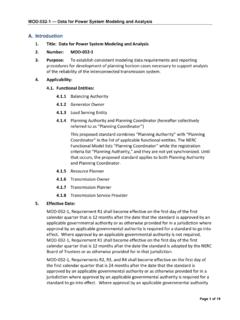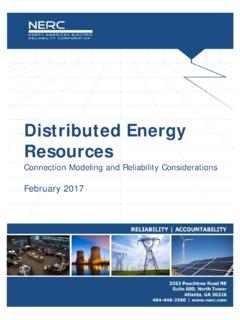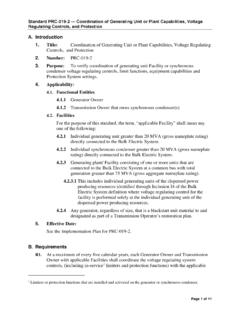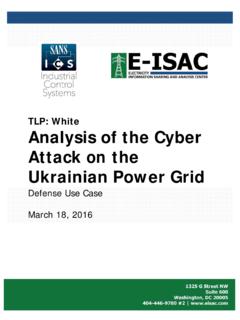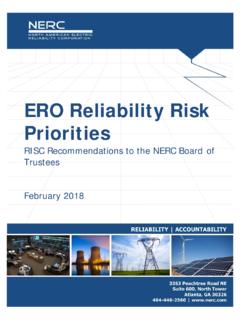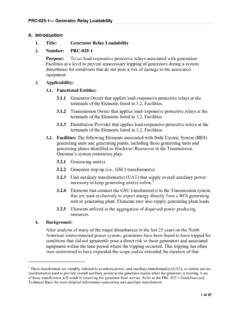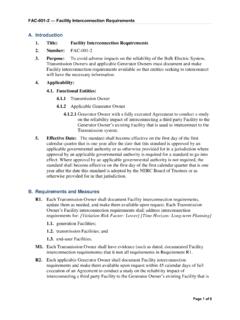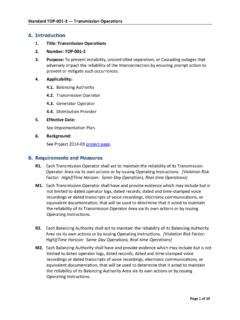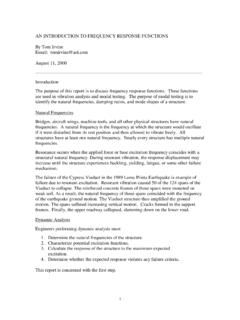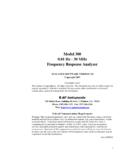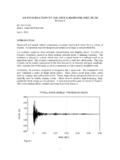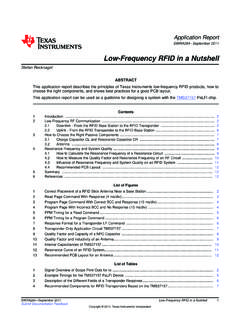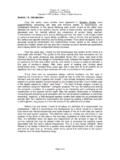Transcription of BAL-001-TRE-1 — Primary Frequency Response in …
1 BAL-001-TRE-1 Primary Frequency Response in the ERCOT Region Page 1 of 49 A. introduction 1. Title: Primary Frequency Response in the ERCOT Region 2. Number: BAL-001-TRE-1 3. Purpose: To maintain Interconnection steady-state Frequency within defined limits. 4. Applicability: Functional Entities: 1. Balancing Authority (BA) 2. Generator Owners (GO) 3. Generator Operators (GOP) Exemptions: Existing generating facilities regulated by the Nuclear Regulatory Commission prior to the Effective Date are exempt from Standard BAL- 001-TRE-01. Generating units/generating facilities while operating in synchronous condenser mode are exempt from Standard BAL-001-TRE-01. Any generators that are not required by the BA to provide Primary Frequency Response are exempt from this standard. 5. Background: The ERCOT Interconnection was initially given a waiver of BAL-001 R2 (Control Performance Standard CPS2).
2 In FERC Order 693, NERC was directed to develop a Regional Standard as an alternate means of assuring Frequency performance in the ERCOT Interconnection. NERC was explicitly directed to incorporate key elements of the existing Protocols, Section This required governors to be in service and performing with an un-muted Response to assure an Interconnection minimum Frequency Response to a Frequency Measurable Event (that starts at t(0)). This regional standard provides requirements related to identifying Frequency Measureable Events, calculating the Primary Frequency Response of each resource in the Region, calculating the Interconnection minimum Frequency Response and monitoring the actual Frequency Response of the Interconnection, setting Governor deadband and droop parameters, and providing Primary Frequency Response performance requirements. Under this standard, two Primary Frequency Response performance measures are calculated: initial and sustained.
3 The initial PFR performance (R9) measures the actual Response compared to the expected Response in the period from 20 to 52 seconds after an FME starts. The sustained PFR performance (R10) measures the best actual Response between 46 and 60 seconds after t(0) compared to the expected Response based on the system Frequency at a point 46 seconds after t(0). In this regional standard the term resource is synonymous with generating unit/generating facility . 6. (Proposed) Effective Date: After final regulatory approval and in accordance with the 30-month Implementation Plan to BAL-001-TRE-1 Primary Frequency Response in the ERCOT Region Page 2 of 49 allow the BA and each generating unit/generating facility time to meet the requirements. See attached Implementation Plan (Attachment 1). B. Requirements R1. The BA shall identify Frequency Measurable Events (FMEs), and within 14 calendar days after each FME the BA shall notify the Compliance Enforcement Authority and make FME information (time of FME (t(0)), pre-perturbation average Frequency , post- perturbation average Frequency ) publicly available.
4 [Violation Risk Factor = Lower] [Time Horizon = Operations Assessment] M1. The BA shall have evidence it reported each FME to the Compliance Enforcement Authority and that it made FME information publicly available within 14 calendar days after the FME as required in Requirement R1. R2. The BA shall calculate the Primary Frequency Response of each generating unit/generating facility in accordance with this standard and the Primary Frequency Response Reference This calculation shall provide a 12-month rolling average of initial and sustained Primary Frequency Response performance. This calculation shall be completed each month for the preceding 12 calendar months. The performance of a combined cycle facility will be determined using an expected performance droop of The calculation results shall be submitted to the Compliance Enforcement Authority and made available to the GO by the end of the month in which they were completed.
5 If a generating unit/generating facility has not participated in a minimum of (8) eight FMEs in a 12-month period, its performance shall be based on a rolling eight FME average Response . [Violation Risk Factor = Lower] [Time Horizon = Operations Assessment] M2. The BA shall have evidence it calculated and reported the rolling average initial and sustained Primary Frequency Response performance of each generating unit/generating facility monthly as required in Requirement R2. R3. The BA shall determine the Interconnection minimum Frequency Response (IMFR) in December of each year for the following year, and make the IMFR, the methodology for calculation and the criteria for determination of the IMFR publicly available. [Violation Risk Factor = Lower] [Time Horizon = Operations Planning] 1 The Primary Frequency Response Reference Document contains the calculations that the BA will use to determine Primary Frequency Response performance of generating units/generating facilities.
6 This reference document is a Texas RE-controlled document that is subject to revision by the Texas RE Board of Directors. BAL-001-TRE-1 Primary Frequency Response in the ERCOT Region Page 3 of 49 M3. The BA shall demonstrate that the IMFR was determined in December of each year per Requirement R3. The BA shall demonstrate that the IMFR, the methodology for calculation and the criteria for determination of the IMFR are publicly available. R4. After each calendar month in which one or more FMEs occurs, the BA shall determine and make publicly available the Interconnection s combined Frequency Response performance for a rolling average of the last six (6) FMEs by the end of the following calendar month. [Violation Risk Factor = Medium] [Time Horizon = Operations Planning] M4. The BA shall provide evidence that the rolling average of the Interconnection s combined Frequency Response performance for the last six (6) FMEs was calculated and made public per Requirement R4.
7 R5. Following any FME that causes the Interconnection s six-FME rolling average combined Frequency Response performance to be less than the IMFR, the BA shall direct any necessary actions to improve Frequency Response , which may include, but are not limited to, directing adjustment of Governor deadband and/or droop settings. [Violation Risk Factor = Medium] [Time Horizon = Operations Planning] M5. The BA shall provide evidence that actions were taken to improve the Interconnection s Frequency Response if the Interconnection s six-FME rolling average combined Frequency Response performance was less than the IMFR, per Requirement R5. R6. Each GO shall set its Governor parameters as follows: Limit Governor deadbands within those listed in Table , unless directed otherwise by the BA. Table Governor Deadband Settings Generator Type Max. Deadband Steam and Hydro Turbines with Mechanical Governors +/- Hz All Other Generating Units/Generating Facilities +/- Hz Limit Governor droop settings such that they do not exceed those listed in Table , unless directed otherwise by the BA.
8 Table Governor Droop Settings Generator Type Max. Droop % Setting Hydro 5% Nuclear 5% BAL-001-TRE-1 Primary Frequency Response in the ERCOT Region Page 4 of 49 Coal and Lignite 5% Combustion Turbine (Simple Cycle and Single-Shaft Combined Cycle) 5% Combustion Turbine (Combined Cycle) 4% Steam Turbine (Simple Cycle) 5% Steam Turbine (Combined Cycle)* 5% Diesel 5% Wind Powered Generator 5% DC Tie Providing Ancillary Services 5% Renewable (Non-Hydro) 5% *Steam Turbines of combined cycle resources are required to comply with Requirements , and Compliance with Requirements R9 and R10 will be determined through evaluation of the combined cycle facility using an expected performance droop of For digital and electronic Governors, once Frequency deviation has exceeded the Governor deadband from Hz, the Governor setting shall follow the slope derived from the formula below.
9 Where MWGCS is the maximum megawatt control range of the Governor control system. For mechanical Governors, droop will be proportional from the deadband by design. [Violation Risk Factor = Medium] [Time Horizon = Operations Planning] M6. Each GO shall have evidence that it set its Governor parameters in accordance with Requirement R6. Examples of evidence include but are not limited to: Governor test reports Governor setting sheets Performance monitoring reports R7. Each GO shall operate each generating unit/generating facility that is connected to the interconnected transmission system with the Governor in service and responsive to Frequency when the generating unit/generating facility is online and released for dispatch, unless the GO has a valid reason for operating with the Governor not in service and the GOP has been notified that the Governor is not in service.
10 [Violation Risk Factor = Medium] [Time Horizon = Real-time Operations] BAL-001-TRE-1 Primary Frequency Response in the ERCOT Region Page 5 of 49 M7. Each GO shall have evidence that it notified the GOP as soon as practical each time it discovered a Governor not in service when the generating unit/generating facility was online and released for dispatch. Evidence may include but not be limited to: operator logs, voice logs, or electronic communications. R8. Each GOP shall notify the BA as soon as practical but within 30 minutes of the discovery of a status change (in service, out of service) of a Governor. [Violation Risk Factor = Medium][Time Horizon = Real-time Operations] M8. Each GOP shall have evidence that it notified the BA within 30 minutes of each discovery of a status change (in service, out of service) of a Governor. R9. Each GO shall meet a minimum 12-month rolling average initial Primary Frequency Response performance of on each generating unit/generating facility, based on participation in at least eight FMEs.

